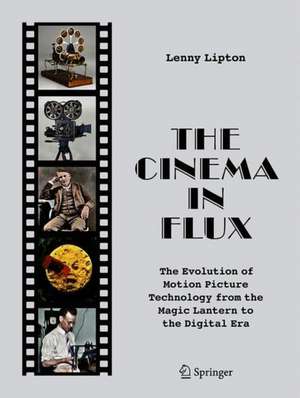The Cinema in Flux: The Evolution of Motion Picture Technology from the Magic Lantern to the Digital Era
Autor Lenny Liptonen Limba Engleză Hardback – 8 apr 2021
The topics are covered sequentially, with detailed discussion of the transition from the magic lantern to Edison’s invention of the 35mm camera, the development of the celluloid cinema, and the transition from celluloid to digital. Unique and essential reading from a lifetime innovator in the field of cinema technology, this engaging and well-illustrated book will appeal to anyone interested in the history and science of cinema, from movie buffs to academics and members of the motion picture industry.
Preț: 425.37 lei
Nou
Puncte Express: 638
Preț estimativ în valută:
81.39€ • 84.99$ • 67.21£
81.39€ • 84.99$ • 67.21£
Carte disponibilă
Livrare economică 25 martie-08 aprilie
Preluare comenzi: 021 569.72.76
Specificații
ISBN-13: 9781071609507
ISBN-10: 1071609505
Pagini: 530
Ilustrații: XXII, 795 p. 577 illus., 259 illus. in color.
Dimensiuni: 210 x 279 x 37 mm
Greutate: 2.4 kg
Ediția:2021
Editura: Springer Us
Colecția Springer
Locul publicării:New York, NY, United States
ISBN-10: 1071609505
Pagini: 530
Ilustrații: XXII, 795 p. 577 illus., 259 illus. in color.
Dimensiuni: 210 x 279 x 37 mm
Greutate: 2.4 kg
Ediția:2021
Editura: Springer Us
Colecția Springer
Locul publicării:New York, NY, United States
Cuprins
Recenzii
“The book features a beautiful iconographic apparatus that, together with its author’s wide-ranging knowledge of technology and material- oriented approach to the evolution of the medium, make it particularly well suited as a companion to more traditional cinema histories for teachers of film courses and scholars of film technology in general.” (Sabrina Negri, Technology and Culture, Vol. 63 (4), October, 2022)
“If you’re studying computer science with a view to working in animation or movie production, you absolutely should read it. And if you’re not, you will find that the pictures and descriptions of the devices that led to what we see in our cinemas today are absolutely fascinating.” (G. K. Jenkins, Computing Reviews, July 4, 2022)
“His point of view is both authoritative and fascinating … . Lenny Lipton's The Cinema in Flux is richly illustrated, and also contains a bibliography, a list of patents, and an index. It is a most pleasurable read, as the author moves joyfully, eruditely, and eloquently between eras, personalities, and systems. An instant classic, no less.” (Laurent Mannoni, Journal of Film Preservation, Issue 105, November, 2021)“If you’re studying computer science with a view to working in animation or movie production, you absolutely should read it. And if you’re not, you will find that the pictures and descriptions of the devices that led to what we see in our cinemas today are absolutely fascinating.” (G. K. Jenkins, Computing Reviews, July 4, 2022)
Notă biografică
Lenny Lipton founded StereoGraphics Corporation in 1980 and was the Chief Technology Officer of RealD during the introduction of digital stereoscopic theatrical exhibition. He led the team that invented the ZScreen, used in more than 30,000 RealD 3-D theaters, and was the first to demonstrate the flickerless projection technique used on 80,000 3-D cinema screens. He has written four books, including Independent Filmmaking (1972) and Foundations of the Stereoscopic Cinema (1982). He is a Fellow of both the SMPTE and the SPIE, and a member of the Scientific Council of the Conservatoire des techniques of the Cinémathèque Française. He’s been granted 72 patents in the field of electronic stereoscopic displays and received a Smithsonian award for his invention of CrystalEyes, the original electronic stereoscopic eyewear product, and he received the Lumiere Lifetime Achievement Award from the Advanced Cinema Society. While majoring in physics at Cornell he wrote the lyrics of the song Puff the Magic Dragon. He produced and directed 25 independent films in the collection of the Pacific Film Archive. He lives in Laurel Canyon, California, with his family.
Textul de pe ultima copertă
The first of its kind, this book traces the evolution of motion picture technology in its entirety. Beginning with Huygens' magic lantern and ending in the current electronic era, it explains cinema’s scientific foundations and the development of parallel enabling technologies alongside the lives of the innovators. Product development issues, business and marketplace factors, the interaction of aesthetic and technological demands, and the patent system all play key roles in the tale.
The topics are covered sequentially, with detailed discussion of the transition from the magic lantern to Edison’s invention of the 35mm camera, the development of the celluloid cinema, and the transition from celluloid to digital. Unique and essential reading from a lifetime innovator in the field of cinema technology, this engaging and well-illustrated book will appeal to anyone interested in the history and science of cinema, from movie buffs to academics and members of the motion picture industry.
The topics are covered sequentially, with detailed discussion of the transition from the magic lantern to Edison’s invention of the 35mm camera, the development of the celluloid cinema, and the transition from celluloid to digital. Unique and essential reading from a lifetime innovator in the field of cinema technology, this engaging and well-illustrated book will appeal to anyone interested in the history and science of cinema, from movie buffs to academics and members of the motion picture industry.
Caracteristici
Chronicles the complete history of motion picture technology from the magic lantern to the current digital era Shows how competing technological, cultural, economic, and legal factors shaped the cinema and TV industries Split into digestible sections and accompanied by plenty of illustrations
